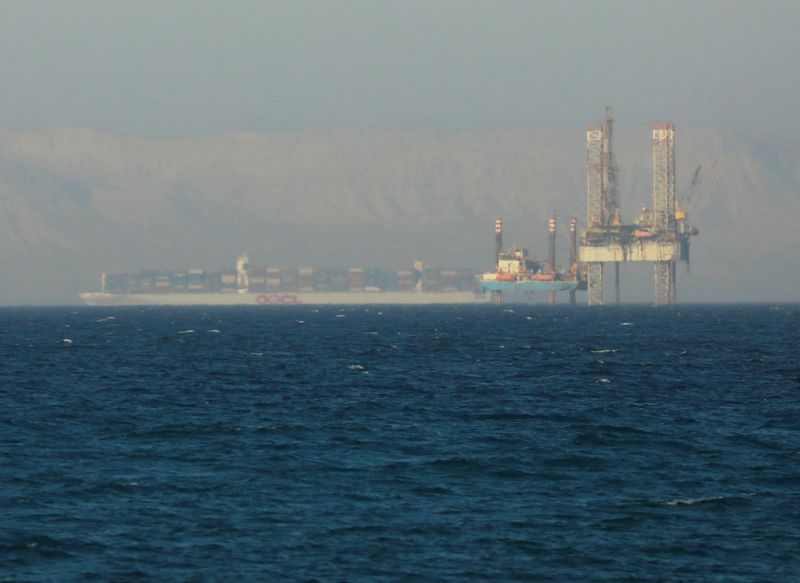Commodities
Oil perks up as Red Sea tensions spark investor jitters


© Reuters. FILE PHOTO: A container ship crosses an oil platform at the Gulf of Suez towards the Red Sea before entering the Suez Canal, outside of Cairo, Egypt September 1, 2020. REUTERS/Amr Abdallah Dalsh/File Photo
By Natalie Grover
LONDON (Reuters) – Global oil benchmark Brent topped $80 a barrel on Wednesday amid jitters over global trade disruption and geopolitical tensions in the Middle East following attacks on ships by Yemen’s Iran-aligned Houthi forces in the Red Sea.
futures rose 89 cents, or 1.1%, at $80.12 a barrel by 1101 GMT, while U.S. West Texas Intermediate crude climbed 93 cents, or 1.3%, to $74.87 a barrel.
The benchmarks closed up more than 1% on Tuesday as some companies rerouted vessels, with longer voyages increasing the cost of transport and insurance.
On Wednesday, Greece advised commercial vessels sailing in the Red Sea and the Gulf of Aden to avoid Yemeni waters. Greek ship-owners control about 20% of the world’s commercial vessels in terms of carrying capacity.
Meanwhile, Washington on Tuesday launched a task force to safeguard commerce in the region.
“Thus far, the U.S.-led naval mission to mitigate Houthi attacks has failed to ease broad concerns of safe passage through the Red Sea, with major maritime carriers still choosing to steer clear amid the tensions,” said Yeap Jun Rong, market strategist at IG.
The Houthis vowed to defy the U.S.-led naval mission and to keep targeting Red Sea shipping in support of Palestinian enclave Gaza’s ruling Hamas movement.
About 12% of world shipping traffic passes up the Red Sea and through the Suez Canal. Although oil supply has been re-aligned, no shortages have yet emerged, analysts said.
“As long as production is not threatened the market will eventually adjust to changing supply routes,” said Saxo Bank analyst Ole Hansen.
ECONOMIC GREENSHOOTS
“It is not a far-fetched thought to attribute the present advance in prices as much to rate cut expectations, falling bond yields and dollar and healthy equity markets as to the geopolitical temperature,” said Tamas Varga of oil broker PVM.
Recent data suggests central bank action to quell sticky inflation in Europe had made a meaningful difference.
German producer prices fell more than expected in November, data showed on Wednesday, a day after another set confirmed that euro zone inflation slowed sharply to 2.4% last month on a year-on-year basis.
In addition, British inflation plunged in November to its lowest rate in over two years, strengthening the case for interest rate cuts.
Traders have also held on to their expectations of 150 bps in rate cuts by the U.S. Federal Reserve next year, which were boosted last week as the bank outlined steeper rate cuts in 2024.
In a separate boost to prices, the U.S. bought 2.1 million barrels of crude for delivery in February, its Energy Department said on Tuesday, as the country continues to replenish its reserves.
and fuel inventories also rose last week, sources said, citing data from the American Petroleum Institute, against analysts’ expectations of a decline in crude stocks in a Reuters poll. [API/S]
Commodities
Oil prices rise; U.S. crude inventories plunge, Russia-Ukraine truce eyed
Commodities
India’s Reliance to stop buying Venezuelan oil over US tariffs, sources say
Commodities
Oil prices climb on Venezuela supply worries

 Forex3 years ago
Forex3 years agoForex Today: the dollar is gaining strength amid gloomy sentiment at the start of the Fed’s week

 Forex3 years ago
Forex3 years agoUnbiased review of Pocket Option broker

 Forex3 years ago
Forex3 years agoDollar to pound sterling exchange rate today: Pound plummeted to its lowest since 1985

 Forex3 years ago
Forex3 years agoHow is the Australian dollar doing today?

 Cryptocurrency3 years ago
Cryptocurrency3 years agoWhat happened in the crypto market – current events today

 World3 years ago
World3 years agoWhy are modern video games an art form?

 Commodities3 years ago
Commodities3 years agoCopper continues to fall in price on expectations of lower demand in China

 Economy3 years ago
Economy3 years agoCrude oil tankers double in price due to EU anti-Russian sanctions























